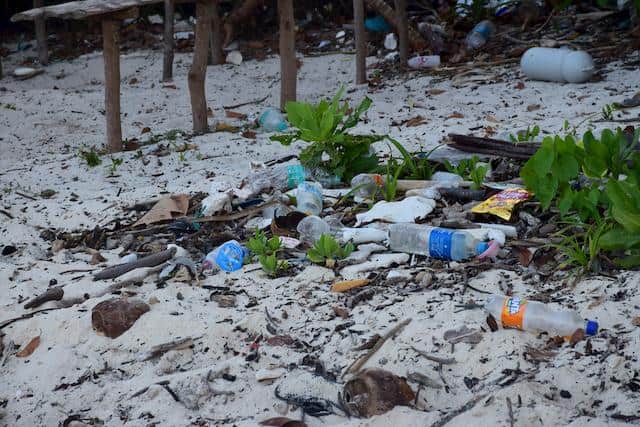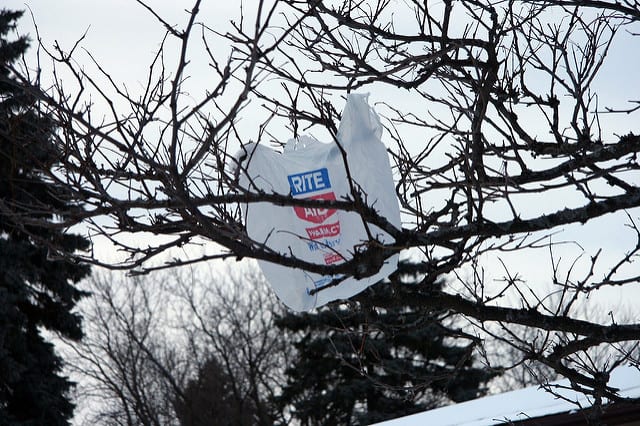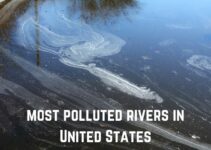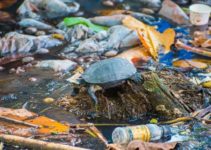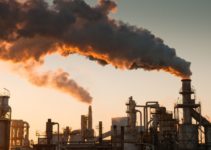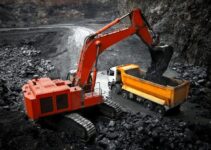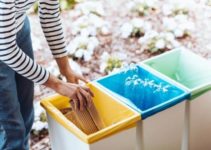As the world’s population grows, so does the amount of garbage that people generate. On-the-go lifestyles necessitate easily disposable products, such as soda cans or water bottles.
Nonetheless, the accumulation of these products has resulted in increasing levels of plastic pollution throughout the world.
Now, since plastic is composed of major toxic pollutants, it can cause significant harm to the environment through air, water, and land pollution.
Plastic pollution occurs when plastic has gathered in an area and has begun to negatively impact the natural environment creating problems for plants, wildlife, and even the human population. Often this includes killing plant life and posing dangers to local animals.
Sure, plastic is an incredibly useful material. In fact, it’s grown to become one of the most commonly used materials by humankind. But again, it is made from toxic compounds known to cause illness and isn’t biodegradable either.
When shopping, carry a paper or cloth bag. Also, avoid bringing plastic bags at home and purchasing items with too much packaging. This way, you can help contribute to the environment by reducing plastic pollution, whose ill effects are irreversible.
In this article, we will look at various causes, effects, and solutions to plastic pollution that you’d wish you’d known.
I am concerned about the air we breathe and the water we drink. If overfishing continues, if pollution continues, many of these species will disappear off the face of the earth.
~ Bernard Marcus
Various Causes of Plastic Pollution
While solving the problem of plastic pollution may seem as easy as just implementing recycling or cleaning up empty bottles, the truth is that the plastic causing the pollution can range in size from big to microscopic. The major contributors to this problem today include:
1. Plain Old Trash
Plastic today is found almost everywhere, even on items you least expect. Milk cartons are lined with it, water bottles are handed out everywhere, and some products may even contain tiny plastic beads.
Now, any time one of these items gets thrown away or washed down a sink, the toxic pollutants have more chance to enter the environment and harm.

Unfortunately, trash dumps and landfills are major problems, as they allow pollutants to enter the ground and affect wildlife and groundwater for years.
2. It is Overused
Plastic is undoubtedly one of the world’s most widely available and overused items today, and rapid urbanization and population growth only increase the demand for this material.
Plus, since this material is more affordable and durable, it is utilized in every other way possible. Packaging materials, plastic bottles and containers, straws, carry bags, etc. That makes it one of the most common materials in our environment.
But the real problem comes through our careless disposable mentality for plastics. I mean, unlike other materials that we tend to hold on to for long, we’re inclined to often dispose of plastic, possibly because it doesn’t cost us much.
However, what most people don’t consider is that as much as it doesn’t cost our wallets much, it does our environment, and that’s because it just doesn’t entirely decompose.
3. Plastic Takes Over 400 Years to Decompose
The chemical bonds that make-up plastics are strong and made to last. The decomposition rate of plastic typically ranges from 500 to 600 years, depending on the type.
And actually, how fast plastic breaks down depends on sunlight exposure. Like our skin, plastics absorb the sun’s ultraviolet (UV) radiation, breaking down into smaller plastic beads after some time without decomposing entirely. This process is called photodegradation, and it’s why landfills often expose plastic waste to the sun to accelerate the breakdown process.
For example, single-use plastic grocery bags take about two decades to break down. In contrast, plastic water bottles made with polyethylene terephthalate (PET), a common type of plastic, are estimated to take approximately 450 years to break down fully.
According to the EPA (Environmental Protection Agency), in the US, every bit of plastic that is ever made and sent to landfills or dumped in the environment still exists.
4. Fishing Nets
Commercial fishing is an economic necessity for many parts of the world, and many people eat fish for daily survival. However, this industry has helped contribute to the problem of plastic pollution in the oceans in several ways.
For one, the nets used for certain large-scale trolling operations are usually plastic. That means as they spend long times submerged in water, they’re more likely to leak toxins, and sometimes they even get broken up or lost and are left to remain wherever they fall.
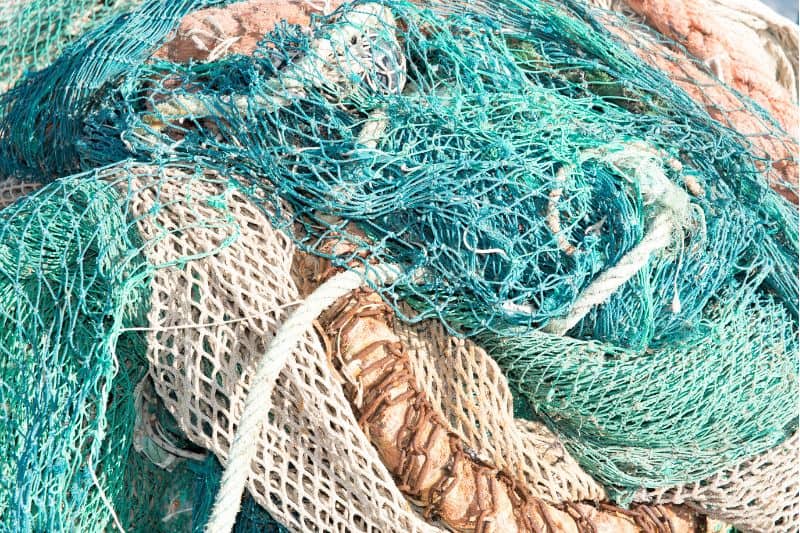
The other way fishing nets exacerbate plastic pollution is through their trapping mechanism. As they’re dragged along, nets may wash plastic waste from ships to shores and water. This not only kills and harms local wildlife but also pollutes the water. Marine animals get trapped in nets and swallow the toxic particles.
5. Disposing of Plastic and Garbage
The disposal of plastic is often mismanaged; it ends up in landfills. This may sound confusing, but plastic is nearly impossible to break down because it is meant to last.
Burning plastics is incredibly toxic and leads to harmful atmospheric conditions and deadly illnesses. Therefore, if it is in a landfill, it releases toxins in that area.
Even recycling doesn’t cut down on plastic, as it essentially uses the existing plastic, albeit in a new form. This process can also lead to plastic irritants being released in other ways.
As new plastic items are manufactured every day, the cycle keeps repeating. Until businesses start using more environmentally friendly, alternative materials (such as paper), this cycle of producing and disposing of plastic will continue.
6. It’s Nature Caused Many of the Times
Many times, waste is transported by the winds. Very light plastic gets blown away in gentle winds and is carried away by the rains into sewers, streams, rivers, and finally, the oceans. Besides, natural disasters such as floods should also be considered as other causes of plastic pollution.
Serious Effects of Plastic Pollution
It seems obvious that this amount of material that isn’t meant to break down can wreak havoc on natural environments, leading to long-term issues for plants, animals, and people. Some of the major long-term effects of plastic pollution are:
1. Negative Effects on Human Health
We are prone to eat plastic-contaminated seafood, as discovered in recent research. Scientists have found microplastics in 114 marine species, and around one-third of these end up on our plates.
The other way that we consume plastic is via packaging. BPAs in many plastic objects come in direct contact with food and are metabolized in the liver to form Bisphenol A, which remains in our body through our urine.
In addition, we drink microplastics via bottled water. The WHO published shocking research in 2018 that exposed the presence of microplastics in 90% of bottled water, a test that revealed only 17 bottles of water were free of plastics out of 259.
But that’s not all. Besides eating and drinking plastic, we absorb it through our clothes, 70% of which are synthetic and the worst fabric for the skin.
We are exposed to plastic gases when the trash is burned in the open air due to poor waste management.
2. It Upsets the Food Chain
Because they come in sizes large and small, polluting plastics even affect the world’s tiniest organisms, such as plankton.
You see, planktons are more likely to ingest plastic toxins in the water. When that happens, they get poisoned, and the plastic is transferred to other organisms higher in the food chain that directly depend on them for food. This can cause many strains at each step along the food chain.
3. Groundwater Pollution
Water conservation is already a concern in places ranging from California to parts of India, but the world’s water is in great danger because of leaking plastics and waste.
If you’ve ever seen a garbage dump, imagine what happens whenever it rains. That definitely means plastic is present in your drinking water, especially considering groundwater and reservoirs are susceptible to leaking environmental toxins.
Most of the litter and pollution affecting the world’s oceans also derive from plastics. This has had terrible consequences on many marine species, which can lead to consequences for those that eat fish and marine life for nutrients – including people.
4. Land Pollution
Plastic dumped in landfills interacts with water and forms hazardous chemicals, which later seep underground and degrade the water quality. The wind carries and deposits plastic from one place to another, increasing the land litter.
It can also get stuck on poles, traffic lights, trees, fences, towers, etc., and animals may come into this vicinity and get suffocated to death.
5. Air Pollution
Burning plastic in the open air leads to environmental pollution due to the release of poisonous chemicals. When inhaled by humans and animals, the polluted air affects their health and can cause respiratory problems.

6. It Kills Animals
Despite countless TV ads over the years showing ducks or dolphins trapped in six-ring plastic can holders, these items are still used and discarded daily.
Mass of plastic has displaced animals or related toxins have poisoned them; plastic pollution does a lot of damage to the world’s ecosystems.
7. It is Poisonous
Man artificially makes plastic by using several toxic chemicals. Therefore, the use of and exposure to plastics have been linked to a number of health concerns affecting people around the world. The processes of making, storing, disposing of, and just being around plastics can be extremely harmful to living things.
8. Cleaning Plastic is Expensive
It costs millions of dollars each year to clean affected areas after exposure, not to mention the loss of life to plants, animals, and people. As land becomes more valuable, finding a place to put garbage is becoming a problem in many parts of the world.
Excess pollution also decreases tourism in affected areas, significantly impacting those economies.
Effective Solutions to Plastic Pollution
The reality is that this problem can be addressed only by individuals and companies worldwide agreeing to implement practices that reduce waste on every level. The top tips for reducing plastic waste are:
1. Shop Friendly
Plastic bags were once a modern convenience but can be efficiently replaced by reusable bags, many of which fold up compactly to be portable.
Just think about how many bags you typically carry out of a grocery store, and multiply that by the number of times you visit the grocery shop. That’s a lot of plastic! Carry a bag and always reuse plastic bags as much as possible if you have them.
2. Get Rid of Bottled Water
People are meant to drink lots of water daily, and plastic water bottles have become a great way to stay hydrated throughout the day.
However, most of these are only recommended for single-use, meaning every time someone finishes a bottle, it goes into the trash. These plastic bottles are typically made from polyethylene terephthalate (Pet), so decomposing naturally takes over 400 years.
Many companies now sell reusable water bottles as a substitute, reducing plastic waste and exposure to leaking bottles. The best thing you can do is carry a reusable metal bottle in your bag.
3. Forget to-go Containers
You would be surprised to know how much plastic is involved in the making and packaging of food containers. Think of the coffee shop’s drink cup is paper. It’s likely lined with plastic for insulation (pour a cup of coffee on some cardboard and see what happens).
Plastic food containers, lids, and utensils are all easily replaced by reusable containers, which will cut down significantly on even a single meal’s waste.
4. Recycle Everything
Try and select items that come in non-plastic and recyclable packaging, which is the best way to handle items that can’t be reused properly. Check everything before you put it in the trash, as more items can be recycled these days.
Remember that because plastic doesn’t break down easily (if ever), recycling plastic means that it is still plastic, just being used for a different purpose. Therefore, you’re not reducing its amounts or exposure, even in recycling.
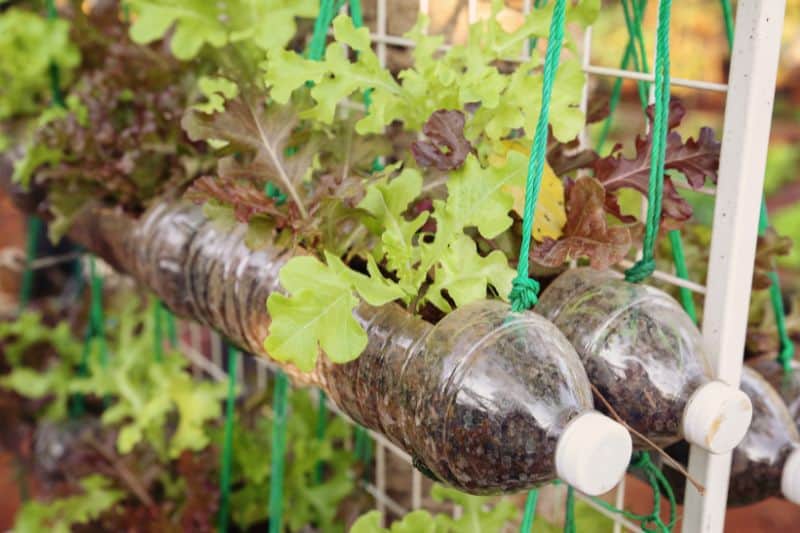
5. Try Living Without Disposable Plastics
We use around 90% of plastic items only once daily and then chucks, such as grocery bags, plastic wraps, disposable cutlery, straws, and coffee-cup lids.
It only takes a few times of bringing your own reusable bags to the store, silverware to the office or carrying a travel mug and a metal reusable drinking bottle to make it a habit.
Making your meals is not only healthier, but it also doesn’t involve takeout containers or doggy bags. When you order in or eat out, tell them you don’t need plastic cutlery or bring your own food-storage containers to restaurants for leftovers.
6. Make Better Choices at Home
You can make a lot of difference by making green choices at home, and you must move away from the throwaway culture. Choose products with less plastic packaging.
Avoid cosmetics and personal hygiene products with microbeads, the little dots in your toothpaste, and facial scrubs, which are microplastic.
New research shows increasing damage from microbeads to marine life and human health. Avoid clothes that have synthetic microfibers. When these items are washed, they often release microfibers into the water, finally making their way to oceans and then being ingested by fish and other marine creatures.
7. Educate Businesses
Speak to local restaurants and businesses about options that they can switch to for packaging, storing, and bagging items. Many companies are starting to develop excellent low-cost replacements, such as bamboo utensils in place of plastic ones.
8. Get Involved
Speak to lawmakers and get involved with the government on any level, and you’ll see how many special interest groups have made it so that we are dependent on plastic without needing to be. Encourage the development of items, and propose alternatives when applicable.
References:
